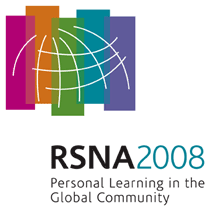
Abstract Archives of the RSNA, 2008
LL-GI4298-L02
Hypervascular Pseudolesions during Dynamic MRI of Cirrhotic Liver: Difference between Non-tumorous and Peritumoral Arterioportal Shunts on Diffusion-weighted Imaging Compared to SPIO-enhanced MRI
Scientific Posters
Presented on December 3, 2008
Presented as part of LL-GI-L: Gastrointestinal
Jin Chung MD, Presenter: Nothing to Disclose
Jeong-Sik Yu MD, Abstract Co-Author: Nothing to Disclose
Jae-Joon Chung MD, Abstract Co-Author: Nothing to Disclose
Joo Hee Kim, Abstract Co-Author: Nothing to Disclose
Ki Whang Kim MD, Abstract Co-Author: Nothing to Disclose
The aim of this study was to distinguish diffusion-weighted imaging (DWI) features comparing to superparamagnetic iron oxide (SPIO)-enhanced imaging between non-tumorous and peritumoral arterioportal shunts in the cirrhotic liver.
Larger than 1 cm localized hypervascular pseudolesions or benign perfusional changes during the dynamic MRI were subjected for comparative analysis of imaging features between DWI using three different b values (50, 400 and 800 s/mm2) and SPIO-enhanced T2 or T2*-weighted imaging according to the different natures of perfusional anomalies. In the 26 patients with cirrhotic liver, 12 non-tumorous arterioportal shunts (group 1), 9 peritumoral hypervascular areas before therapy (group 2) and 12 peritumoral hypervascular areas developed after locoregional therapy for hepatocellular carcinoma (group 3). The relative signal intensity compared with background parenchyma corresponding to the hypervascular area on dynamic MRI was scored with a 4-grade scale on DWI using different b values and SPIO-enhanced images, in addition to pre-contrast T2-weighted images. Pearson chi-square test was used to discriminate the differences among three groups.
All of the group 1 lesions showed no distinguishable hyperintensity on any of the DWIs and SPIO-enhanced images. Group 3 lesions tended to be more hyperintense than group 2 lesions on DWIs (p = 0.009 on b = 50 s/mm2; p = 0.02 on b = 400 s/mm2; p = 0.025 on b = 800 s/mm2) whereas pre-contrast T2-weighted images (p = 0.11), SPIO-enhanced T2-weighted images (p = 0.077) and SPIO-enhanced T2*-weighted images (p = 0.095) showed no significant difference between group 2 and 3.
Non-tumorous arterioportal shunts are easily characterized by negative findings on both DWI and SPIO-enhanced MRI. For the perilesional hypervascular areas, DWI could be more reliable than SPIO-enhanced MRI to exclude substantial parenchymal changes which should be differentiated from malignancy.
Diffusion-weighted imaging has a potential to distinguish perfusion-related mild parenchymal changes from substantial parenchymal injuries, which are not well discriminated by SPIO-enhance MRI.
Chung, J,
Yu, J,
Chung, J,
Kim, J,
Kim, K,
Hypervascular Pseudolesions during Dynamic MRI of Cirrhotic Liver: Difference between Non-tumorous and Peritumoral Arterioportal Shunts on Diffusion-weighted Imaging Compared to SPIO-enhanced MRI. Radiological Society of North America 2008 Scientific Assembly and Annual Meeting, February 18 - February 20, 2008 ,Chicago IL.
http://archive.rsna.org/2008/6014224.html

